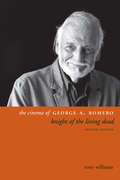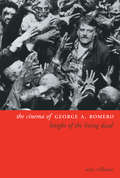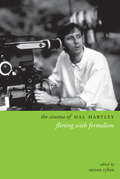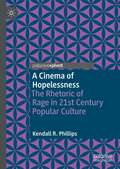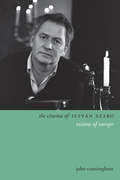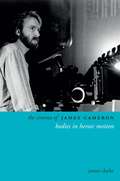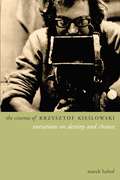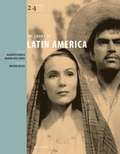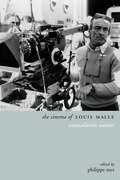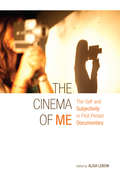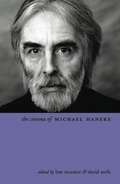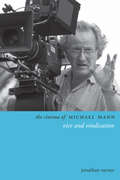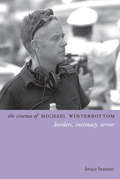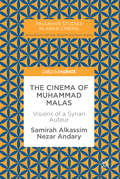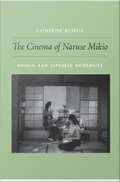- Table View
- List View
The Cinema of George A. Romero: Knight of the Living Dead, Second Edition (Directors' Cuts)
by Tony WilliamsIn this comprehensive portrait of horror's definitive director, Tony Williams ties George A. Romero's films to the development of literary naturalism and American culture, expanding the artist's creative footprint beyond his mastery of the "splatter movie" genre. Williams locates Romero's influences in the work of Emile Zola, the Entertainment Comics of the 1950s, and the novels of Stephen King, revealing the interdisciplinary depth of his seminal films Night of the Living Dead (1968), Creepshow (1982), Monkey Shines (1988), and The Dark Half (1992). For this second edition, Williams reads Romero's Bruiser (2000) against his more recent Land of the Dead (2005) and takes a fresh look at Diary of the Dead (2007) and Survival of the Dead (2009), two overlooked films that feature Romero's greatest achievements yet.
The Cinema of George A. Romero
by Tony WilliamsThe Cinema of George A. Romero: Knight of the Living Dead is the first in-depth study in English of the career of this foremost auteur working at the margins of the Hollywood mainstream in the horror genre. In placing Romero's oeuvre in the context of literary naturalism, the book explores the relevance of the director's films within American cultural traditions and thus explains the potency of such work beyond 'splatter movie' models. The author explores the roots of naturalism in the work of Emile Zola and traces this through to the EC Comics of the 1950s and on to the work of Stephen King. In so doing, the book illuminates the importance of seminal Romero texts such as Night of the Living Dead (1968), Creepshow (1982), Monkey Shines (1988), The Dark Half (1992). This study also includes full coverage of Romero's latest feature, Bruiser (2000), as well as his screenplays and teleplays.
The Cinema of Hal Hartley: Flirting with Formalism (Directors' Cuts)
by Steven RybinOver the course of nearly thirty years, Hal Hartley has cultivated a reputation as one of America's most steadfastly independent film directors. From his breakthrough films – The Unbelievable Truth (1989), Trust (1990), and Simple Men (1992) – to his recently completed 'Henry Fool' trilogy, Hartley has honed a rigorous, deadpan, and instantly recognizable film style informed by both European modernism and playful revisions of Classical Hollywood genres. Featuring new essays on this important director and his films, this collection explores Hartley's work from a variety of aesthetic, cultural, and economic contexts, while also looking closely at his collaborations with actors, the contexts of his authorial reputation, his reworking of the romantic comedy and other genres, and the shifting economics of his filmmaking.This book, up-to-date through Hartley's latest film, Ned Rifle (2014), includes new scholarship on the director's early work as well as reflections on his cinema in connection with new theories and approaches to independent filmmaking. Covering the entire trajectory of his career, including both his features and short films, the book also includes new readings of several of Hartley's seminal films, including Amateur (1994), Flirt (1995), and Henry Fool (1997).
A Cinema of Hopelessness: The Rhetoric of Rage in 21st Century Popular Culture (Rhetoric, Politics and Society)
by Kendall R. PhillipsThis book explores the circulation of anger and hostility in contemporary American culture with particular attention to the fantasy of refusal, a dream of rejecting all the structures of the contemporary political and economic system. Framing the question of public sentiment through the lens of rhetorical studies, this book traces the circulation of symbols that craft public feelings in contemporary popular cinema. Analyzing popular twenty-first century films as invitations to a particular way of feeling, the book delves into the way popular sentiments are circulated and intensified. The book examines dystopian films (The Purge, The Cabin in the Woods), science fiction (Snowpiercer), and superhero narratives (the Marvel Cinematic Universe and Joker). Across these varied films, an affective economy that emphasizes grief, betrayal, refusal, and an underlying rage at the seeming hopelessness of contemporary culture is uncovered. These examinations are framed in terms of ongoing political protests ranging from Occupy Wall Street, the Tea Party, Black Lives Matter, and the 6th January 2021 invasion of the US Capitol Building.
The Cinema of István Szabó: Visions of Europe (Directors' Cuts)
by John CunninghamIstván Szabó is one of Hungary's most celebrated and best-known film directors, and the first Hungarian to have won an Academy Award for Best Foreign Language Film, for Mephisto (1981). In a career spanning over five decades Szabó has relentlessly examined the place of the individual in European history, particularly those caught up in the turbulent events of Central Europe and his own native Hungary. His protagonists struggle to find a place for themselves, some meaning in their lives, security and a sense of being, against a background of two world wars (Colonel Redl, Confidence), the Holocaust (Sunshine), the Hungarian Uprising, and the Cold War (Father, 25 Fireman's Street, Taking Sides). This is the first English-language study of all his feature films and uses material from interviews with Szabó and his collaborators. Also included are chapters on his formative years, including his time at the famous Budapest Film Academy and the relationship of the state to the film industry in Hungary.
The Cinema of István Szabó: visions of Europe
by John CunninghamThe first English-language study of all Szabó's feature films and uses material from interviews with him and his collaborators
The Cinema of István Szábo
by John CunninghamIstván Szabó is one of Hungary's most celebrated and best-known film directors, and the only Hungarian to have won an Academy Award for Best Foreign Language Film, for Mephisto (1981). In a career spanning over five decades Szabó has relentlessly examined the place of the individual in European history, particularly those caught up in the turbulent events of Central Europe and his own native Hungary. His protagonists struggle to find a place for themselves, some meaning in their lives, security and a sense of being, against a background of two world wars (Colonel Redl, Confidence), the Holocaust (Sunshine), the Hungarian Uprising and the Cold War (Father, 25 Fireman's Street, Taking Sides). This is the first English-language study of all his feature films and uses material from interviews with Szabó and his collaborators. Also included are chapters on his formative years, including his time at the famous Budapest Film Academy and the relationship of the state to the film industry in Hungary.
The Cinema of James Cameron: Bodies in Heroic Motion (Directors' Cuts)
by James ClarkeThis timely volume explores the massively popular cinema of writer-director James Cameron. It couches Cameron's films within the evolving generic traditions of science fiction, melodrama, and the cinema of spectacle. The book also considers Cameron's engagement with the aesthetic of visual effects and the 'now' technology of performance-capture which is arguably moving a certain kind of event-movie cinema from photography to something more akin to painting. This book is explicit in presenting Cameron as an authentic auteur, and each chapter is dedicated to a single film in his body of work, from The Terminator to Avatar. Space is also given to discussion of Strange Days as well as his short films and documentary works.
The Cinema of James Cameron
by James ClarkeThis timely volume explores the massively popular cinema of writer-director James Cameron. It couches Cameron's films within the evolving generic traditions of science fiction, melodrama, and the cinema of spectacle. The book also considers Cameron's engagement with the aesthetic of visual effects and the 'now' technology of performance-capture which is arguably moving a certain kind of event-movie cinema from photography to something more akin to painting. This book is explicit in presenting Cameron as an authentic auteur, and each chapter is dedicated to a single film in his body of work. Space is also given to discussion of Strange Days as well as his documentary works.
The Cinema of James Cameron
by James ClarkeThis timely volume explores the massively popular cinema of writer-director James Cameron. It couches Cameron's films within the evolving generic traditions of science fiction, melodrama, and the cinema of spectacle. The book also considers Cameron's engagement with the aesthetic of visual effects and the 'now' technology of performance-capture which is arguably moving a certain kind of event-movie cinema from photography to something more akin to painting. This book is explicit in presenting Cameron as an authentic auteur, and each chapter is dedicated to a single film in his body of work. Space is also given to discussion of Strange Days as well as his documentary works.
The Cinema of Krzysztof Kieslowski: Variations on Destiny and Chance (Directors' Cuts)
by Marek HaltofSince his death in 1996, Krzysztof Kieslowski has remained the best-known contemporary Polish filmmaker and one of the most popular and respected European directors, internationally renowned for his ambitious Decalogue and Three Colors trilogy. In this new addition to the Directors'Cuts series, Marek Haltof provides a comprehensive study of Kieslowski's cinema, discussing industrial practices in Poland and stressing that the director did not fit the traditional image of a "great" East-Central European auteur. He draws a fascinating portrait of the stridently independent director's work, noting that Kieslowski was not afraid to express unpopular views in film or in life. Haltof also shows how the director's work remains unique in the context of Polish documentary and narrative cinema.
The Cinema of Krzysztof Kieslowski: Variations on Destiny and Chance
by Marek HaltofSince his death in 1996, Krzysztof Kieslowski has remained the best-known contemporary Polish filmmaker and one of the most popular and respected European directors, internationally renowned for his ambitious Decalogue and Three Colors trilogy. In this new addition to the Directors'Cuts series, Marek Haltof provides a comprehensive study of Kieslowski's cinema, discussing industrial practices in Poland and stressing that the director did not fit the traditional image of a "great" East-Central European auteur. He draws a fascinating portrait of the stridently independent director's work, noting that Kieslowski was not afraid to express unpopular views in film or in life. Haltof also shows how the director's work remains unique in the context of Polish documentary and narrative cinema.
The Cinema of Latin America
by Alberto Elena Díaz López MarinaThe Cinema of Latin America is the first volume in the new 24 Frames series of studies of national and regional cinema. In taking an explicitly text-centered approach, the books in this series offer a unique way of considering the particular concerns, styles and modes of representation of numerous national cinemas around the world. This volume focuses on the vibrant practices that make up Latin American cinema, a historically important regional cinema and one that is increasingly returning to popular and academic appreciation. Through 24 individual concise and insightful essays that each consider one significant film or documentary, the editors of this volume have compiled a unique introduction to the cinematic output of countries as diverse as Brazil, Argentina, Cuba, Mexico, Bolivia, Chile and Venezuala. The work of directors such as Luis Buñuel, Thomas Guiterrez Alea, Walter Salles, and Alfonso Arau is discussed and the collection includes in-depth studies of seminal works as such Los Olvidados, The Hour of the Furnaces, Like Water For Chocolate, Foreign Land, and Amoros Perros.
The Cinema of Latin America (24 Frames)
by Alberto Elena Díaz López Marina Eds.The Cinema of Latin America is the first volume in the new 24 Frames series of studies of national and regional cinema. In taking an explicitly text-centered approach, the books in this series offer a unique way of considering the particular concerns, styles and modes of representation of numerous national cinemas around the world. This volume focuses on the vibrant practices that make up Latin American cinema, a historically important regional cinema and one that is increasingly returning to popular and academic appreciation. Through 24 individual concise and insightful essays that each consider one significant film or documentary, the editors of this volume have compiled a unique introduction to the cinematic output of countries as diverse as Brazil, Argentina, Cuba, Mexico, Bolivia, Chile and Venezuala. The work of directors such as Luis Buñuel, Thomas Guiterrez Alea, Walter Salles, and Alfonso Arau is discussed and the collection includes in-depth studies of seminal works as such Los Olvidados, The Hour of the Furnaces, Like Water For Chocolate, Foreign Land, and Amoros Perros.
The Cinema of Louis Malle: Transatlantic Auteur (Directors' Cuts)
by Philippe MetArguably a pioneer of the French New Wave (with Ascenseur pour l’échafaud, 1957) Louis Malle went on to enjoy an acclaimed yet provocative and versatile transatlantic career. This collection of original essays proposes to reassess his richly eclectic and boldly subversive oeuvre and redress the surprising critical neglect it has suffered over the years. It does so through a combination of transversal and monographic analyses that use a variety of critical lenses and theoretical tools in order to examine Malle’s documentaries as well as his fiction features (and, more importantly, the constant shuttling and uniquely persistent cross-pollination between those two cinematic approaches), illuminate the profound, lasting dialogue his films entertained with literature and theater, bring to the fore their sustained, albeit often oblique autobiographical thrust along with their scathing sociopolitical critique, and scrutinize the alternating use of stars and non-professional actors.In addition, the volume features an exclusive interview with the acclaimed playwright John Guare (a close friend and collaborator of Louis Malle’s who scripted Atlantic City) and is bookended by a foreword by Volker Schlöndorff and an afterword by Wes Anderson, two renowned filmmakers who articulate their admiration for, and the seminal influence of, their predecessor.
The Cinema of Me
by Alisa LebowWhen a filmmaker makes a film with herself as a subject, she is already divided as both the subject matter of the film and the subject making the film. The two senses of the word are immediately in play - the matter and the maker - thus the two ways of being subjectified as both subject and object. Subjectivity finds its filmic expression, not surprisingly, in very personal ways, yet it is nonetheless shaped by and in relation to collective expressions of identity that can transform the cinema of 'me' into the cinema of 'we'. Leading scholars and practitioners of first-person film are brought together in this groundbreaking collection to consider the theoretical, ideological, and aesthetic challenges wrought by this form of filmmaking in its diverse cultural, geographical, and political contexts.
The Cinema of Me: The Self and Subjectivity in First Person Documentary (Nonfictions)
by Lebow Alisa ed. Preface by Michael Renov.When a filmmaker makes a film with herself as a subject, she is already divided as both the subject matter of the film and the subject making the film. The two senses of the word are immediately in play – the matter and the maker—thus the two ways of being subjectified as both subject and object. Subjectivity finds its filmic expression, not surprisingly, in very personal ways, yet it is nonetheless shaped by and in relation to collective expressions of identity that can transform the cinema of 'me' into the cinema of 'we'. Leading scholars and practitioners of first-person film are brought together in this groundbreaking collection to consider the theoretical, ideological, and aesthetic challenges wrought by this form of filmmaking in its diverse cultural, geographical, and political contexts.
The Cinema of Michael Haneke: Europe Utopia
by Ben Mccann David SorfaMichael Haneke is one of the most important directors working in Europe today, with films such as Funny Games (1997), Code Unknown (2000), and Hidden (2005) interrogating modern ethical dilemmas with forensic clarity and merciless insight. Haneke's films frequently implicate both the protagonists and the audience in the making of their misfortunes, yet even in the barren nihilism of The Seventh Continent (1989) and Time of the Wolf (2003) a dark strain of optimism emerges, releasing each from its terrible and inescapable guilt. It is this contingent and unlikely possibility that we find in Haneke's cinema: a utopian Europe. This collection celebrates, explicates, and sometimes challenges the worldview of Haneke's films. It examines the director's central themes and preoccupations--bourgeois alienation, modes and critiques of spectatorship, the role of the media--and analyzes otherwise marginalized aspects of his work, such as the function of performance and stardom, early Austrian television productions, the romanticism of The Piano Teacher (2001), and the 2007 shot-for-shot remake of Funny Games.
The Cinema of Michael Haneke: Europe Utopia (Directors' Cuts)
by Ben McCann Sorfa David Eds.Michael Haneke is one of the most important directors working in Europe today, with films such as Funny Games (1997), Code Unknown (2000), and Hidden (2005) interrogating modern ethical dilemmas with forensic clarity and merciless insight. Haneke's films frequently implicate both the protagonists and the audience in the making of their misfortunes, yet even in the barren nihilism of The Seventh Continent (1989) and Time of the Wolf (2003) a dark strain of optimism emerges, releasing each from its terrible and inescapable guilt. It is this contingent and unlikely possibility that we find in Haneke's cinema: a utopian Europe. This collection celebrates, explicates, and sometimes challenges the worldview of Haneke's films. It examines the director's central themes and preoccupations—bourgeois alienation, modes and critiques of spectatorship, the role of the media—and analyzes otherwise marginalized aspects of his work, such as the function of performance and stardom, early Austrian television productions, the romanticism of The Piano Teacher (2001), and the 2007 shot-for-shot remake of Funny Games.
The Cinema of Michael Mann: Vice and Vindication (Directors' Cuts)
by Jonathan RaynerMichael Mann is one of the most important American filmmakers of the past forty years. His films exhibit the existential concerns of art cinema, articulated through a conspicuous and recognizable visual style and yet integrated within classical Hollywood narrative and genre frameworks. Since his beginnings as a screenwriter in the 1970s, Mann has become a key figure within contemporary American popular culture as writer, director, and producer for film and television. This volume offers a detailed study of Mann's feature films, from The Jericho Mile (1979) to Public Enemies (2009), with consideration also being given to parallels in the production, style, and characterization in his television work. It explores Mann's relationship with classical genres, his thematic concentration on issues of morality and masculinity, his film adaptations from literature, and the development and significance of his trademark visual style within modern American cinema.
The Cinema of Michael Mann
by Jonathan RaynerMichael Mann is one of the most important American filmmakers of the past forty years. His films exhibit the existential concerns of art cinema, articulated through a conspicuous and recognizable visual style and yet integrated within classical Hollywood narrative and genre frameworks. Since his beginnings as a screenwriter in the 1970s, Mann has become a key figure within contemporary American popular culture as writer, director, and producer for film and television. This volume offers a detailed study of Mann's feature films, from The Jericho Mile (1979) to Public Enemies (2009), with consideration also being given to parallels in the production, style, and characterization in his television work. It explores Mann's relationship with classical genres, his thematic concentration on issues of morality and masculinity, his film adaptations from literature, and the development and significance of his trademark visual style within modern American cinema.
The Cinema of Michael Winterbottom: Borders, Intimacy, Terror (Directors' Cuts)
by Bruce BennettThis comprehensive study of prolific British filmmaker Michael Winterbottom explores the thematic, stylistic, and intellectual consistencies running through his eclectic and controversial body of work. This volume undertakes a close analysis of a TV series directed by Winterbottom and sixteen of his films ranging from television dramas to transnational co-productions featuring Hollywood stars, and from documentaries to costume films. The critique is centered on Winterbottom's collaborative working practices, political and cultural contexts, and critical reception. Arguing that his work delineates a 'cinema of borders', this study examines Winterbottom's treatment of sexuality, class, ethnicity, and national and international politics, as well as his quest to adequately narrate inequality, injustice, and violence.
The Cinema of Michael Winterbottom
by Bruce BennettThis comprehensive study of prolific British filmmaker Michael Winterbottom explores the thematic, stylistic, and intellectual consistencies running through his eclectic and controversial body of work. Within an overview of his career, this volume undertakes a close analysis of fifteen of Winterbottom's films ranging from TV dramas to transnational coproductions featuring Hollywood stars, and from documentaries to costume films. This analysis is grounded in a consideration of Winterbottom's collaborative working practices, the political and cultural contexts of the work, and its critical reception. Arguing that Winterbottom's work comprises a 'cinema of borders', it examines its treatment of sexuality, class, ethnicity, national and international politics. The book argues that what is evident in Winterbottom's oeuvre is the search for an adequate means of narrating inequality, injustice, and violence. Drawing out the tensions, contradictions, and border-crossing strategies of these films, The Cinema of Michael Winterbottom highlights the complex political aesthetic that structures the work of this singular director.
The Cinema of Muhammad Malas: Visions of a Syrian Auteur (Palgrave Studies in Arab Cinema)
by Samirah Alkassim Nezar AndaryThis book provides an in-depth and intimate study of the cinema of Muhammad Malas. One of the well-known auteurs of Arab and Syrian cinema, Malas’s distinctive cinematic project has always confronted the social and political issues of his time. From feature films Dreams of the City, The Night, Bab al Maqam (Passion), and Ladder to Damascus to documentaries such as The Dream and Aleppo: Maqamat of Pleasure, Malas’s films challenge and explore Arab culture and history. Archival images run through the chapters of this book which combines insightful interviews with excerpts from Malas’s literary works and critical explorations of his cinematic style and thematic concerns. The book concludes with Malas’s own words, sharing the treatment of his film project Cinema al-Dunya.
The Cinema of Naruse Mikio: Women and Japanese Modernity
by Catherine RussellOne of the most prolific and respected directors of Japanese cinema, Naruse Mikio (1905-69) made eighty-nine films between 1930 and 1967. Little, however, has been written about Naruse in English, and much of the writing about him in Japanese has not been translated into English. With The Cinema of Naruse Mikio, Catherine Russell brings deserved critical attention to this under-appreciated director. Besides illuminating Naruse's contributions to Japanese and world cinema, Russell's in-depth study of the director sheds new light on the Japanese film industry between the 1930s and the 1960s. Naruse was a studio-based director, a company man renowned for bringing films in on budget and on time. During his long career, he directed movies in different styles of melodrama while displaying a remarkable continuity of tone. His films were based on a variety of Japanese literary sources and original scripts; almost all of them were set in contemporary Japan. Many were "women's films. " They had female protagonists, and they depicted women's passions, disappointments, routines, and living conditions. While neither Naruse or his audiences identified themselves as "feminist," his films repeatedly foreground, if not challenge, the rigid gender norms of Japanese society. Given the complex historical and critical issues surrounding Naruse's cinema, a comprehensive study of the director demands an innovative and interdisciplinary approach. Russell draws on the critical reception of Naruse in Japan in addition to the cultural theories of Harry Harootunian, Miriam Hansen, and Walter Benjamin. She shows that Naruse's movies were key texts of Japanese modernity, both in the ways that they portrayed the changing roles of Japanese women in the public sphere and in their depiction of an urban, industrialized, mass-media-saturated society.
